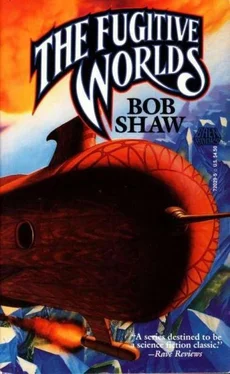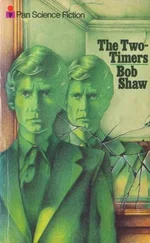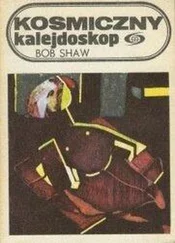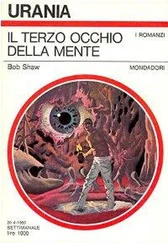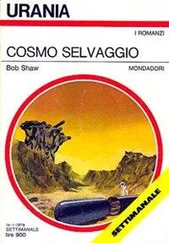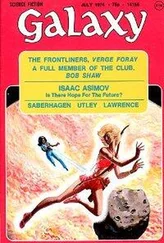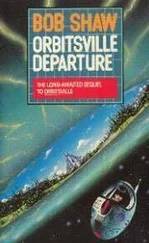Bob Shaw - The Fugitive Worlds
Здесь есть возможность читать онлайн «Bob Shaw - The Fugitive Worlds» весь текст электронной книги совершенно бесплатно (целиком полную версию без сокращений). В некоторых случаях можно слушать аудио, скачать через торрент в формате fb2 и присутствует краткое содержание. Год выпуска: 1990, ISBN: 1990, Издательство: Baen Books, Жанр: Фантастика и фэнтези, на английском языке. Описание произведения, (предисловие) а так же отзывы посетителей доступны на портале библиотеки ЛибКат.
- Название:The Fugitive Worlds
- Автор:
- Издательство:Baen Books
- Жанр:
- Год:1990
- ISBN:0-671-72029-5
- Рейтинг книги:3 / 5. Голосов: 1
-
Избранное:Добавить в избранное
- Отзывы:
-
Ваша оценка:
- 60
- 1
- 2
- 3
- 4
- 5
The Fugitive Worlds: краткое содержание, описание и аннотация
Предлагаем к чтению аннотацию, описание, краткое содержание или предисловие (зависит от того, что написал сам автор книги «The Fugitive Worlds»). Если вы не нашли необходимую информацию о книге — напишите в комментариях, мы постараемся отыскать её.
The Fugitive Worlds — читать онлайн бесплатно полную книгу (весь текст) целиком
Ниже представлен текст книги, разбитый по страницам. Система сохранения места последней прочитанной страницы, позволяет с удобством читать онлайн бесплатно книгу «The Fugitive Worlds», без необходимости каждый раз заново искать на чём Вы остановились. Поставьте закладку, и сможете в любой момент перейти на страницу, на которой закончили чтение.
Интервал:
Закладка:
“Spare me,” Toller cut in. “This is a serious matter—I need to know the size of that… thing out there.”
“Fly towards it and take note of how it expands.”
Toller shook his head. “I have a better idea. I have no intention of turning back unless all other options are denied me—therefore we will fly towards the edge of the circle. Its exact diameter in miles is not all that significant. The truly important thing is to ascertain whether or not we can fly our ship around the obstacle.
“Do you wish to remain at the controls?”
“I would value the experience, sir,” Steenameert replied. “What burner rhythm do you require?”
Toller hesitated, frowning, frustrated by the fact that no practicable air speed indicator had ever been developed for use on skyships. An experienced pilot could get some idea of his speed from the slackening of the rip line as the crown of the balloon was depressed by air resistance, but the abundance of variables made accuracy impossible. It would not have been beyond Kolcorronian ingenuity to devise a reliable instrument, but the motivation had never been present. A skyship’s job was to crawl up and down between the planetary surface and the weightless zone—a journey which always took roughly five days on each leg—and a difference of a few miles an hour was neither here nor there.
“Give it two and six,” Toller said. “We shall pretend to ourselves that we are making twenty miles in the hour and base all our estimates accordingly.”
“But what is the nature of the barrier?” Commissioner Kettoran said from close behind Toller. He was in an upright position, holding the edge of the cane partition with one hand and keeping a quilt around him with the other.
Toller’s first impulse was to request him to lie down again to achieve the complete rest which had been prescribed by the base physician, then it occurred to him that in the absence of weight it made no difference which attitude was adopted by a person with a heart condition. Allowing his thoughts to be diverted into irrelevancies, he visualized a new use for the pathetic little group of defense stations in the weightless zone. Properly heated and supplied with good air, they could best serve as rest centers for those with certain kinds of ailment. Even a cripple would be…
“I’m addressing you, young Maraquine,” Kettoran said peevishly. “What is your opinion of that curious object?”
“I think it might be made of ice.”
“But where would such a vast quantity of water come from?”
Toller shrugged. “We have had rocks and even pieces of metal descend on us from the stars—perhaps the void also contains water.”
“A likely story,” Kettoran grumbled. He gave a theatrical shrug and his long, solemn face—now purple with the cold—slowly sank from view as he returned to his cocoon of downy quilts.
“It’s an omen,” he added, his voice muffled and indistinct from behind the partition. “I know an omen when I see one.”
Toller nodded, smiling thinly in skepticism, and returned to his vigil at the gondola’s rail. By calling out-the firing times for the various lateral jets he helped Steenameert guide the ship into a course which closed with the fire-sheet at an unknown angle, aiming it for the westernmost edge. The main jet was roaring in a steady two-six rhythm and Toller knew that the ship’s speed could easily be as much as his putative twenty miles an hour—but the aspect of the sheet did not alter noticeably with the passing of the minutes.
“Our friend, the omen, appears to be a veritable giant,” he said to Steenameert. “We may have some trouble in getting around him.”
Wishing he had the simple navigational instruments available on the humblest airship, Toller kept his gaze on the eastern rim of the great circle, willing it to descend and thus prove that the ship was making significant progress. He was just beginning to convince himself that he could indeed see a change in the vital angle, when the glowing sheet was swept by waves of prismatic color. They moved at breathtaking orbital speed, crossing the entire disk in mere seconds and stilling Toller’s heart with their message that cosmic events were taking place, reminding him of how unimportant the affairs of mankind were when measured against the grandeur of the universe. The sun, already hidden from his view by the icy screen, was being further occulted by Overland. As soon as the bands of color—engendered by the refraction of the sun’s light in Overland’s atmosphere—had fled into infinity the disk’s overall luminosity began to decrease. Night was falling in the weightless zone.
Here, so close to the datum plane, the terms “night” and “littlenight” no longer had any relevance. Each diurnal cycle was punctuated by two periods of darkness approximately equal in length, and Toller knew it would be some four hours before the sun reappeared. The hiatus could hardly have come at a more inconvenient time.
“Sir?” Steenameert, a sentient pyramid of swaddling in the fading light, had no need to voice the full question.
“Keep going, but reduce thrust to one and six,” Toller ordered. “We can shut down the jet altogether if we find we can’t keep a check on our course. And be sure to keep the balloon well inflated.”
Grateful for Steenameert’s competence, Toller remained at the rail and studied the disk. Sunlight was still being reflected from Land—which was now directly behind him—so the icy wall remained visible, and with the change in illumination he began to see hints of an internal structure. There was a tracery of the palest violet, arranged like rivers which divided and kept on dividing until they faded from the sight, lost in distant shimmers.
They’re like veins, Toller thought. Veins in a giant eye…
As Land was gradually enveloped in Overland’s shadow the disk steadily darkened to near-blackness, but its edge was still clearly defined against the cosmic background. The rest of the sky was now ablaze with its customary extravagance of galaxies—glowing whirlpools ranging from circles to slim ellipses—plus formless ribbons of light, myriads of stars, comets and darting meteors. Against that luminous richness the disk was more mysterious than ever—a featureless well of night which had no right to exist in a rational universe.
By occasionally ordering a slight pendulum movement of the ship Toller was able to look ahead and satisfy himself that it was on course for the disk’s western edge. As the hours of darkness dragged by the air became progressively thinner and less satisfying to the lungs, evidence that the skyship was far from the center of the invisible bridge that linked the two worlds. Although Commissioner Kettoran did not voice any complaint, his breathing became clearly audible. He had mixed some firesalt with water in a vellum bag and could be heard sniffing from it at frequent intervals.
When at last daylight returned, heralded by a brightening of the disk’s western rim, Toller found he could see the rim without having to tilt the ship. Perspective returned; geometry again became a useful tool.
“We’re only a mile or so from the edge,” he announced for the benefit of Steenameert and Kettoran. “In a few minutes we should be able to work around it and head back into the good air.”
“It’s about time!” Kettoran scowled face appeared above the passenger compartment partition. “How far to the side have we travelled?”
“Perpendicular to the ideal course, we must have done in the region of thirty miles—” Toller glanced at Steenameert and received a nod of confirmation—“which means we are dealing with a lake, a sea, of ice some sixty miles across. I find it hard to credit what I’m saying, even though I am looking straight at the thing. Nobody in Prad is going to believe what we say.”
Читать дальшеИнтервал:
Закладка:
Похожие книги на «The Fugitive Worlds»
Представляем Вашему вниманию похожие книги на «The Fugitive Worlds» списком для выбора. Мы отобрали схожую по названию и смыслу литературу в надежде предоставить читателям больше вариантов отыскать новые, интересные, ещё непрочитанные произведения.
Обсуждение, отзывы о книге «The Fugitive Worlds» и просто собственные мнения читателей. Оставьте ваши комментарии, напишите, что Вы думаете о произведении, его смысле или главных героях. Укажите что конкретно понравилось, а что нет, и почему Вы так считаете.
